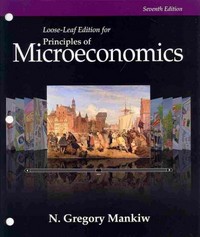Question
1) Using the concept of price elasticity of demand, show on a graph (and discuss) what a sugary drink tax that has no effect on
1) Using the concept of price elasticity of demand, show on a graph (and discuss) what a sugary drink tax that has no effect on consumption would look like.
2) Using the graph you drew in question (1), describe the main effects of the tax on welfare (i.e. surplus')?
3)Do you think the actual price elasticity of demand for sugary drinks is elastic or inelastic? Provide arguments for both possibilities.
4) Using graphs for the market for sugary drinks, and the market for an untaxed drink (e.g. bottled water), show the effects of a sugary drinks tax on the price and quantity traded in the untaxed drink market.
5) Imagine a sugary drinks tax already exists. The government then increases the tax with the intent to raise tax revenue. In which scenario will they do so more successfully - when the price elasticity of demand is elastic or inelastic? Assume the price elasticity of supply is the same across both scenarios.
6) What is the problem being addressed by a sugary drinks tax? State the problem in terms of the concept of 'externalities', ensuring you explain the link between this concept and sugary drinks. Explain how the tax is able to address the problem.
7) Depict on a graph a perfectly competitive market with the externality you discussed in question (6). Utilise the graph to clearly highlight and discuss the problems associated with this externality. [hint: focus on the quantity difference between the market equilibrium and the socially desirable equilibrium] Now consider what happens if the market consolidates and becomes a monopoly (there is no need to depict this on the graph). Do you think the externality problem you previously highlighted will increase or decrease? [hint: focus on the quantity difference between a monopoly and perfectly competitive market]
8) Should governments consider adopting a price floor on sugary drinks, instead of taxes? Why, or why not?


 Using Concept of price elasticity. dink drink ( par litre ) Effects of sugar the Supply ( plus Sugar levy) tax per litre P Demand Quantity ( Itrs ) The Inelasticity of demand indicates that the quantity demanded following the Introduction of the fax will fall by only Small amount.4 pria Pz - NO Quantity7 Marginal Social Cost . Marginal Social Value $ 2
Using Concept of price elasticity. dink drink ( par litre ) Effects of sugar the Supply ( plus Sugar levy) tax per litre P Demand Quantity ( Itrs ) The Inelasticity of demand indicates that the quantity demanded following the Introduction of the fax will fall by only Small amount.4 pria Pz - NO Quantity7 Marginal Social Cost . Marginal Social Value $ 2 Step by Step Solution
There are 3 Steps involved in it
Step: 1

Get Instant Access to Expert-Tailored Solutions
See step-by-step solutions with expert insights and AI powered tools for academic success
Step: 2

Step: 3

Ace Your Homework with AI
Get the answers you need in no time with our AI-driven, step-by-step assistance
Get Started


